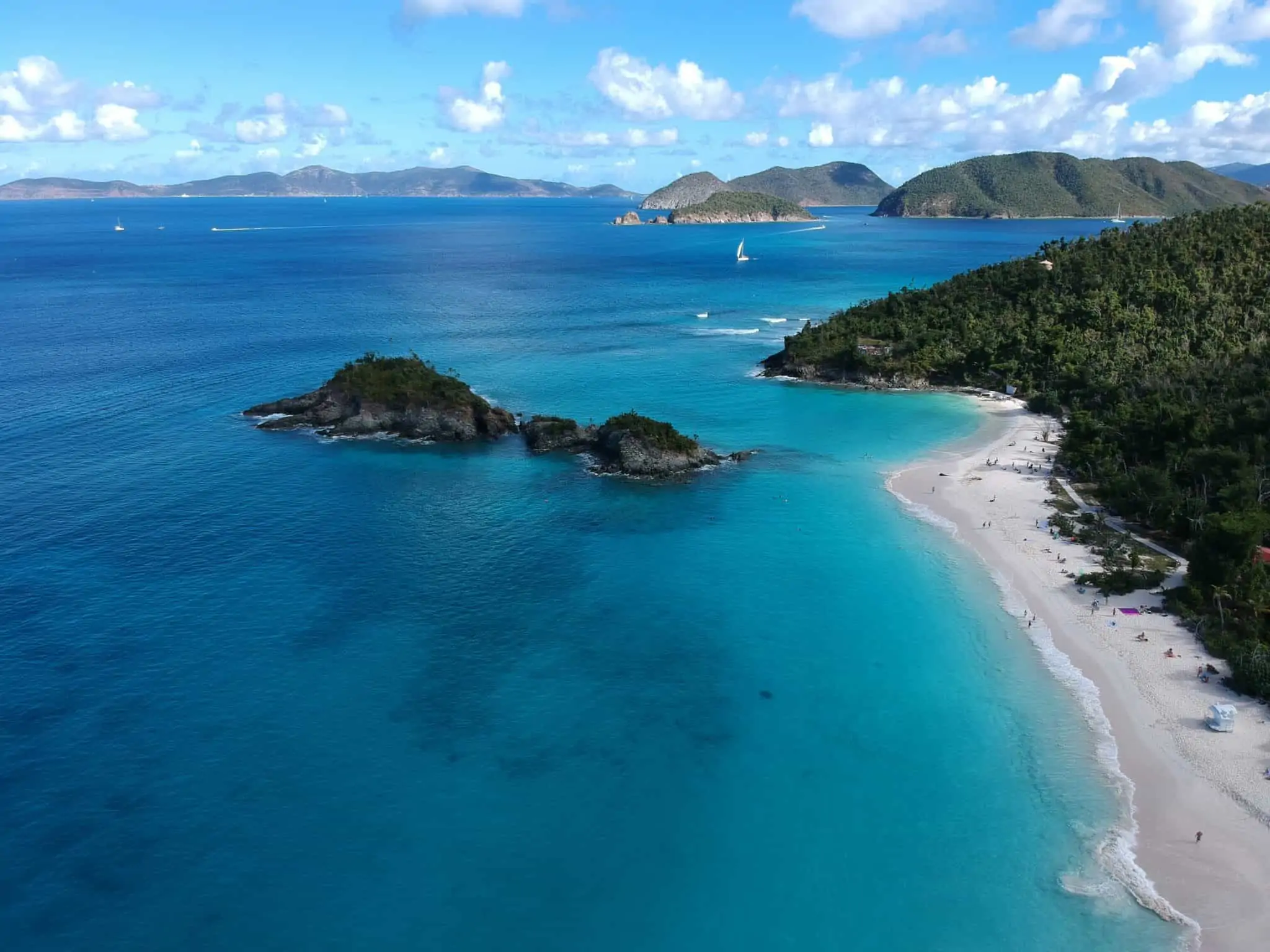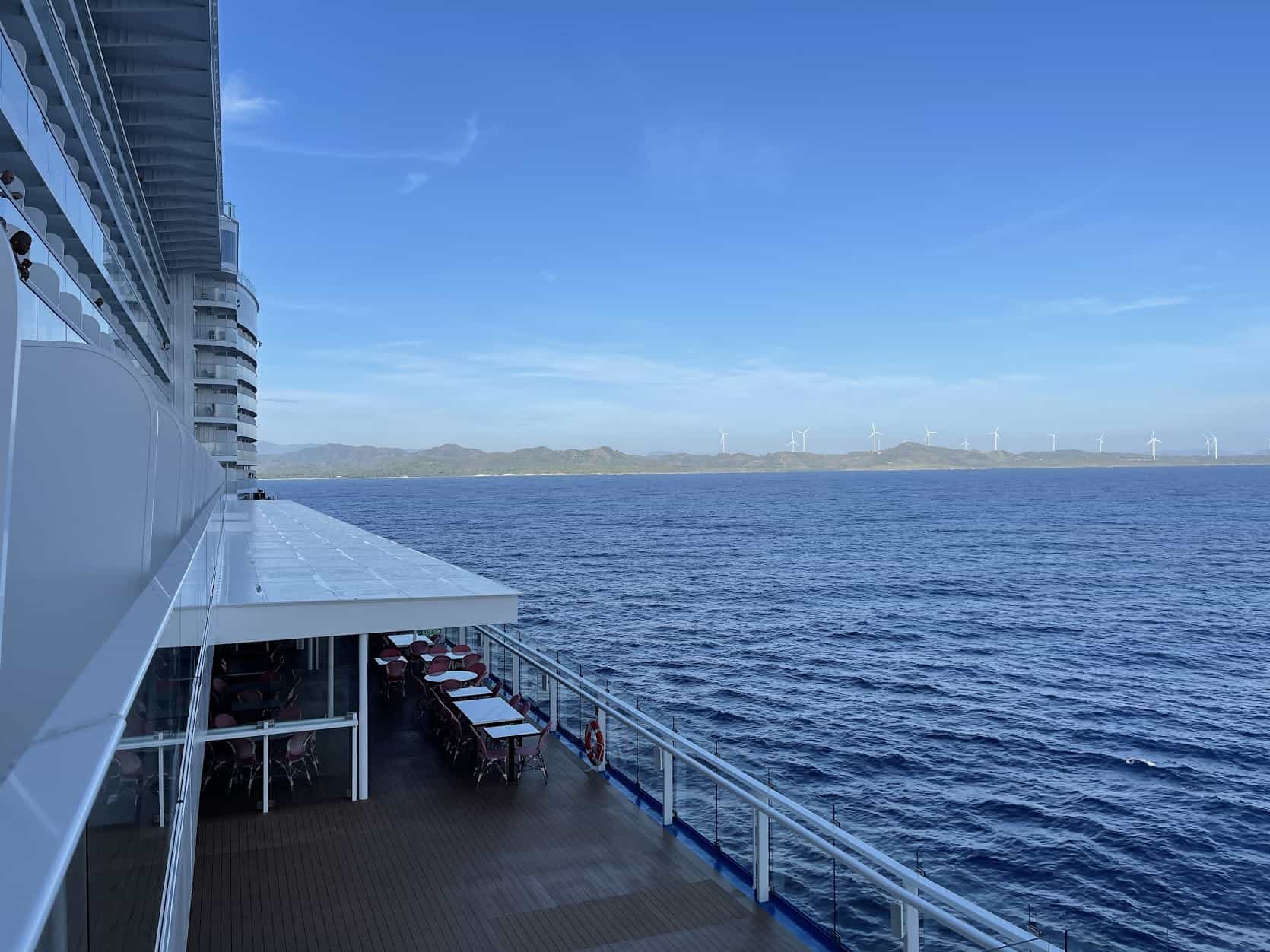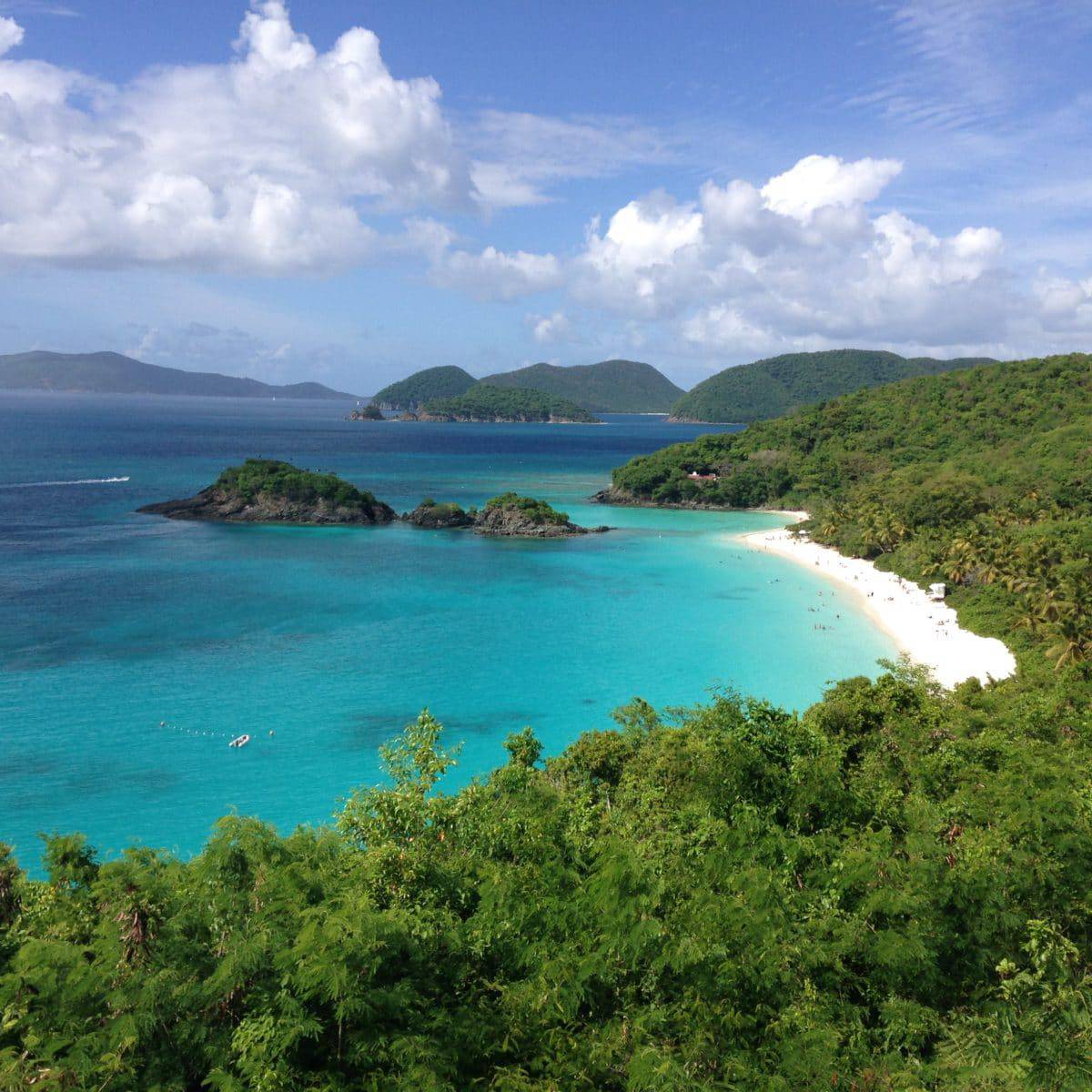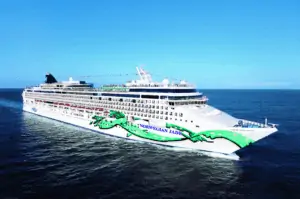Choosing between an Eastern vs. Western Caribbean cruise is a common question for cruisers looking for warm weather during the winter months.

The decision involves weighing various factors and preferences to determine which side of the Caribbean best suits your interests.
I’ll share key elements in this article to help you choose the right Caribbean cruise.
Geographical Overview

Many travelers think Caribbean destinations are all the same, but this is not the case when looking at the Eastern vs. Western Caribbean.
Islands in the Eastern Caribbean tend to be smaller and more mountainous than those in the west. You will often find dense rainforests with volcanic terrain and stunning beaches in the Eastern Caribbean. Additionally, the east water is usually calmer and ideal for water sports.

The west side of the Caribbean offers a more wide-ranging experience with larger landmasses and diverse landscapes, from the tropical rainforests in Honduras to the arid coastal areas in Mexico.
Even the underwater world is different within the Eastern and Western Caribbean. The west is a popular hotspot for scuba diving, along with the Mesoamerican Barrier Reef, which is along the coast of Belize and Mexico.
At the same time, the east offers some of the world’s most popular beaches, from Playa Flamenco in San Juan to Magens Bay in St. Thomas.
Itineraries and Ports

When comparing Eastern vs. Western Caribbean ports, you will find that the East is known for its lush landscapes, beautiful beaches, and historic sites.
At the same time, the West is popular for travelers looking to explore the underwater world with world-class snorkeling and scuba diving.
The Eastern Caribbean includes ports like:
- St. Thomas, USVI
- Tortola, BVI
- San Juan, Puerto Rico
- Amber Cove, Dominican Republic
- Grand Turk, Turks and Caicos
- St. Maarten
Western Caribbean includes ports like:
- Cozumel, Mexico
- Costa Maya, Mexico
- Roatan, Honduras
- Belize City, Belize
- Georgetown, Cayman Islands
- Various ports in Jamaica

When comparing Western vs. Eastern itineraries, the West takes you through pristine natural scenery, with the opportunity to hike through Mayan ruins and jump into deep blue cenotes in Tulum, Mexico or swim with the stingrays in Grand Cayman.
In the east, you may find yourself hiking to waterfalls in El Yunque National Park in Puerto Rico or relaxing at Trunk Bay in St. John.
Embarkation Ports
Popular departure ports for Eastern Caribbean cruises include Miami and Fort Lauderdale in Florida, San Juan in Puerto Rico, and longer-length voyages from New York.
When cruising to the western side of the Caribbean, ships will most likely leave from Miami, Tampa, or Fort Lauderdale in Florida or New Orleans and Galveston in the Gulf of Mexico.

When comparing cruise length vs. western routes, you can generally find shorter cruise options to the east, starting at only four or five nights (Grand Turk), while the shortest cruise you can take to the west is four nights (Cozumel).
Longer cruises tend to showcase the Eastern side of the Caribbean, with many options ranging from 9-12 nights, while most western Caribbean cruises are more in the week-long variety. Take this into consideration while planning your cruise.

When looking at eastern vs. western Caribbean cruises, you will find that the east offers more picture-perfect beaches typically associated with Caribbean cruising.
Eastern Caribbean
| Eastern Caribbean Stats | |
|---|---|
| Average Temperature | 82 Fahrenheit or 27 Celcius |
| Rainy Season | June through November |
| Average Cruise Length | Seven nights |
| Average Cost | Starting at $699 |
| Popular Ports | St. Thomas, St. Maarten, Nassau, and San Juan |
| Popular Activities | Swimming, sunbathing, eco-adventures, snorkeling, and shopping |
Destinations like St. Thomas, St. Maarten, and The Bahamas deliver what guests want in a tropical getaway – stunning white sand beaches, palm trees, and clear water.
These destinations are also top snorkeling and diving spots where you can explore vibrant coral reefs and old shipwrecks in places like the U.S Virgin Islands and Puerto Rico.

You may find yourself exploring many historical sites and cultural experiences when on the Eastern side of the Caribbean.
At the same time, landside, the destinations are dotted with old forts, museums, and vibrant local markets. The east is also perfect for island hopping, with the opportunity to visit multiple islands and experience diverse cultures on a single voyage.
Western Caribbean
| Western Caribbean Stats | |
|---|---|
| Average Temperature | 86 Fahrenheit or 30 Celcius |
| Rainy Season | June through November |
| Average Cruise Length | Seven nights |
| Average Cost | Starting at $799 |
| Popular Ports | Cozumel, Costa Maya, Belize City, and Roatan |
| Popular Activities | Swimming, sunbathing, snorkeling, and diving |
On the other hand, Western Caribbean cruises feature ports like Cozumel, Belize, and Honduras, well known for their adventurous activities and adrenaline-filled sports, attracting thrill-seekers worldwide.
Here, you can take a tube ride through caves, go ziplining, or engage in watersports like snorkeling in the Grand Cayman or swimming with dolphins in Roatan. Of course, if all you want to do is relax on the sand with a book and a cocktail, that’s fine, too.

However, western Caribbean beaches aren’t as famous for their idyllic beachside locales as their Eastern Caribbean counterparts.
One plus of the western Caribbean is the rich cultural side, where you can soak up the sun as you learn about the Mayan culture and the rich history of Mexico by visiting local markets and sampling local street food.
Shopping

Shopping experiences for cruise passengers in the Eastern and Western Caribbean ports offer different options.
Eastern Caribbean ports, such as St. Thomas and St. Maarten, are famous for high ticket shops, including jewelry, watches, and designer brands, often at duty-free prices. These ports are also known for local crafts and unique souvenirs.

On the other hand, Western Caribbean stops, such as Cozumel and Grand Cayman, offer a more diverse shopping scene, focusing on local artisanal products like handmade crafts, textiles, and local spirits. Western ports also have a variety of outdoor markets, where visitors can immerse themselves in the vibrant local culture and find unique, region-specific items.
However, both regions cater well to tourists, ensuring a broad range of options from high-end boutiques to local market stalls.
Best Time to Go

The best time to go depends on your weather preferences and tolerance for crowds.
Generally, the peak season for both regions is between December and April, offering warm and dry weather, perfect for beach activities and exploring ports. However, this period also sees higher prices and more crowded ships and destinations.
If you prefer fewer crowds and potential deals, the late spring and early fall months can be ideal, but it’s important to note that this coincides with the hurricane season (June to November), which may bring unpredictable weather. Traveling during this off-peak season requires flexibility and careful monitoring of weather forecasts.
Hurricanes

Hurricane season, which runs from June 1 to November 30, affects the entire Caribbean – and the East and Gulf Coasts – so you should be mindful when booking a cruise.
Canceling a cruise outright is uncommon since cruise lines also have financial interests in operating these voyages. If you’re planning a Caribbean cruise in the summer or fall, it’s important to keep an eye on the weather, have backup plans in case of unfavorable conditions, and consider buying travel insurance.
Temps
The western Caribbean is typically hotter and more humid than the east, but not so much. Destinations along the west, like Jamaica, Grand Cayman, and Belize, tend to be warmer and more humid during summer, with temperatures approaching 90 degrees Fahrenheit.
At the same time, the Eastern side is usually a bit cooler, averaging around 70 to 80 degrees Fahrenheit.
Examples of Caribbean Sailings

No matter which Caribbean cruise lines you choose, you will find numerous options for the east and west of the Caribbean. Many different cruise lines do both itineraries. Here are a few examples:
Disney Cruise Line Sailings
For this example, let’s use Disney Cruise Line’s Caribbean itineraries for Eastern vs. Western cruises.
On their western Caribbean routes, Disney ships visit ports like Costa Maya, Progreso, and Cozumel in Mexico, George Town, Grand Cayman, and Falmouth, Jamaica.
While Eastern Caribbean sailings typically include destinations such as Philipsburg, St. Maarten; Charlotte Amalie, St. Thomas, U.S. Virgin Islands; Tortola, British Virgin Islands; and Puerto Plata in the Dominican Republic.
Royal Caribbean Sailings
As for other cruise lines, Royal Caribbean alone has 287 itineraries on the Eastern Caribbean and 104 from along the western side.

Carnival Cruise Line Voyages
Carnival Cruise Line’s itineraries are very similar to other operators, with Eastern itineraries typically including stops at ports such as San Juan, Puerto Rico, St. Thomas, U.S. Virgin Islands, St. Maarten, and the Bahamas, with western itineraries featuring ports such as Cozumel, Mexico, Grand Cayman, Jamaica, and Belize.
Norwegian Cruise Line Voyages
As for itinerary length, Norwegian Cruise Line’s voyages western itineraries usually run from 5-7 days, while the Eastern route has itineraries from 5-10 days.
So, as you can see, the Eastern and Western itineraries are consistent among cruise operators, but duration can vary among the lines.
Safety in Ports

Like on any vacation – a seagoing adventure or on land – you should always be mindful of your surroundings and implement safety measures when traveling to the Eastern or Western Caribbean.
While it is highly unlikely that you will encounter any crime or danger, particularly if you stay within the tourist areas or take an organized excursion through the cruise line, precautions should always be taken when traveling.

When comparing cruise safety between the western Caribbean vs. Eastern Caribbean, you will find that there are safer destinations and destinations with higher crime rates on both sides.
Some of the safest Caribbean islands include the Cayman Islands in the west, Montserrat in the east, and the British Virgin Islands in the Eastern Caribbean. Islands with higher crime rates include Haiti and Trinidad and Tobago in the western Caribbean. While these islands have higher crime rates, most issues are internal and unrelated to tourists or resort areas.
A Focus on Beaches

Regardless of what side of the Caribbean you visit, you will find gorgeous, white-sand beaches – after all, isn’t that what a Caribbean cruise is all about? Choosing which side has better beaches is hard, but the Eastern Caribbean might have a slight nod as it features some of the world’s most beautiful and famous beaches.

From Trunk Bay in St. John to Dickenson Bay in Antigua, the eastern Caribbean boasts picturesque white-sand beaches and see-to-the-bottom turquoise waters lined with vibrant palm trees. The western Caribbean is picture-perfect with its white beaches and blue waters.

Popular beach spots along the west include the Seven Mile Beach in Grand Cayman and Montego Bay, Jamaica. The Eastern Caribbean wins by a thread regarding the best beaches, but you can’t go wrong with either side.
Seasonal Differences in the Caribbean

Seasonal considerations play a significant role when planning a Caribbean cruise, but the different seasons don’t vary too much between the Eastern and Western Caribbean.
Winter and Spring
| Due to the mild, dry weather on both the east and west sides, Winter is a popular season for Caribbean cruises – particularly northerners trying to escape the cold. Western vs. Eastern Caribbean in Spring don’t differ much, but this is a popular time to visit both regions. With comfortable temperatures and less humidity, winter and spring is the ideal time for Caribbean cruising, whether it’s snorkeling or scuba diving, exploring coastal towns, or enjoying fun in the sun. |
Summer and Fall
| Summer marks the start of the hurricane season in the Eastern Caribbean. While it’s possible to have a successful cruise during the summer, you are at a higher risk of having your itinerary modified due to a tropical storm or hurricane. The western Caribbean is less prone to hurricanes during this time, but they are not unheard of, and it is hot and humid during the summer. Early fall is the peak of hurricane season, and travelers should exercise caution when visiting the Eastern Caribbean. And while itineraries are adjusted to avoid severe weather, rarely a cruise is outright canceled due to a storm. |
While not all parts of the Eastern and Western Caribbean are affected equally by hurricanes, both sides run the risk during these months. The Eastern side of the Caribbean typically sees a higher risk of hurricanes, but both east and west are at risk of hurricanes and tropical storms.

Choosing between an Eastern and Western Caribbean cruise is a great dilemma – in the end, you can’t go wrong visiting either side of this amazing cruising region, right? – but deciding based on your specific vacation preferences is important.








![First Time Cruise to Europe + Cruise News [Podcast]](jpg/1681310099-msc-world-europa-maiden-call-genoa-italy-1-300x206.jpg)
